This month, back-to-school time will mean more than just new clothes and new school supplies to hundreds of kids in the Stapleton and surrounding areas. For students at four schools, it will mean going to a new school or a new building—or both. High Tech Elementary and DSST: Conservatory Green are new programs that will share a building in Conservatory Green. Isabella Bird Community School, after a year in temporary quarters, is moving to it’s new building in the Bluff Lake neighborhood. And Denver Discovery Middle School is a brand new program in the space occupied by McAuliffe last year.
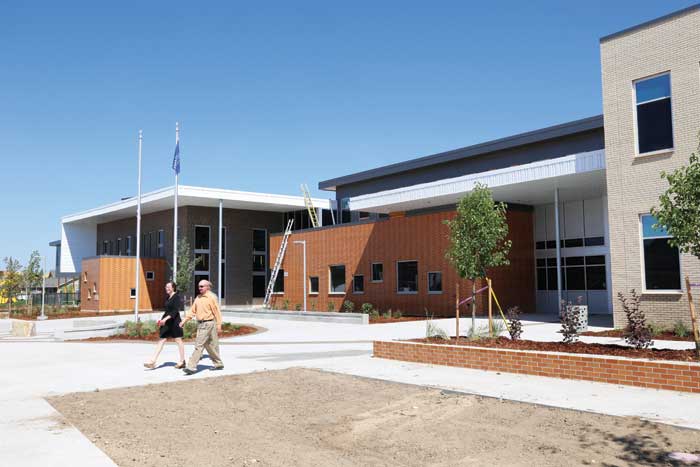
The Conservatory Green building houses High Tech Elementary and DSST: Conservatory Green and will open this fall.
High Tech Elementary

With the school still under construction, High Tech Elementary School Principal Amy Gile stands in front of the beetle-kill-pine wall in the office of her school’s library. The building will be ready in time for the first day of school on August 25.

In the music room of High Tech Elementary, Gile explains that the pyramid-shaped panels in the ceiling provide sound-proofing so the music won’t disturb science classes in session directly above.
High Tech Elementary and DSST: Conservatory Green share the “Conservatory Green” building in its namesake neighborhood north of I-70. While the two schools share several common areas,
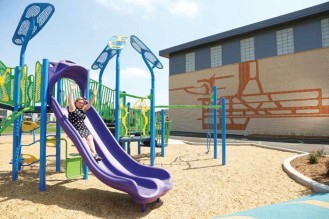
Gile gets a head start having fun with students on the school’s new playground. An image of Stapleton’s former runways adorns the wall as a reminder of the neighborhood’s former life.
High Tech Elementary Principal Amy Giles is particularly excited about the library. The high-ceilinged room, with touches of beetle kill pine (a material that is repeated throughout the building), can handle multiple activities from small-group reading to research to checking out books. Twenty to thirty percent of the library’s titles will be e-books the students can download and read at
home. “We’re trying to move into a more 21st Century approach to the library,” explains Giles. Encouraging literacy as well as research skills in the library backs the school’s focus on project-based-learning, which will expand with the school’s growth. This year, High Tech Elementary will serve approximately 200 students in Early Childhood Education (ECE) through 2nd grade. The school will add one grade per year, expanding to 5th grade and up to 600 students.
High Tech Elementary and DSST:Conservatory Green will share a music room that will have two pianos donated by the University of Colorado at Denver, lockers to store instruments, and practice rooms. Acoustic tiles in the ceiling prevent any musical distraction to the science classrooms directly above. Giles says, in addition to the aesthetic value of windows on both interior and exterior walls, the windows emphasize the idea that the classroom is not a closed environment—people can see in and see out.
Outside, a nature-themed playground includes flower and vegetable garden areas that will be used as an outdoor classroom. Three separate parking areas will help eliminate congestion during drop-off and pick-up: one for ECE parking to facilitate parents coming in to sign-in children; a “kiss-and-go” drop off area, and an area for bus-only traffic.
DSST: Conservatory Green

John Clark, Principal, DSST: Conservatory Green, stands overlooking the cafeteria of the new school that is still under construction. The multi-purpose space will also be used for performances on the stage and for assemblies.

The halls of DSST: Conservatory Green will soon be filled with 125 sixth graders when the school opens in August.
The Denver School of Science and Technology’s side of the Conservatory Green building opens to a multi-story open area that serves as a shared cafeteria, assembly space, and performance venue, with a large, raised stage that gives performers the limelight. This area will enable DSST: Conservatory Green Middle School to establish its performing and musical arts offerings in addition to the school’s digital arts specialization. “All DSST campuses, with the mill levy passing, have been able to add on a much richer arts component to our schools,” says Principal John Clark. “But we’re realizing how important computer science and the digital arts are in preparing kids for college and work in the 21st century.”
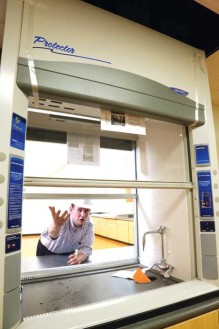
Clark explains how fumes will be drawn up into one of two chemical hoods, allowing for a greater range of experiments in the school’s science labs.
Clark is especially excited to have two adjacent science classrooms that have chemical hoods to provide safety and ventilation when certain chemicals are used. He points out such as ceilings shaped to refract natural light to provide better lighting to the classroom.
The Dean of Students’ office was purposely placed amongst the classrooms. “We’re really lucky because there is a main administrative office down one wing. But the Dean of Students will be closer to the kids. It’s a really great way to set it up. It makes it easier for him, so the kids can see him as often as possible,” says Clark.
The school will start with 150 6th graders and add one class each year through grade 8.
In addition to sharing some school spaces, Clark and High Tech Elementary Principal, Amy Giles are also sharing resources, ideas and even a PE teacher. However, the schools operate on separate budgets. “I believe that, while operating two separate schools, we know the value of working with each other,” says Clark.
The two schools will look for mentoring opportunities to bring the schools together as the school year progresses. “For our sixth graders, this year in particular, the idea of being role models is important to us—that you are the big kids on this campus, respecting and guiding all the kids on campus.”
Isabella Bird Community School
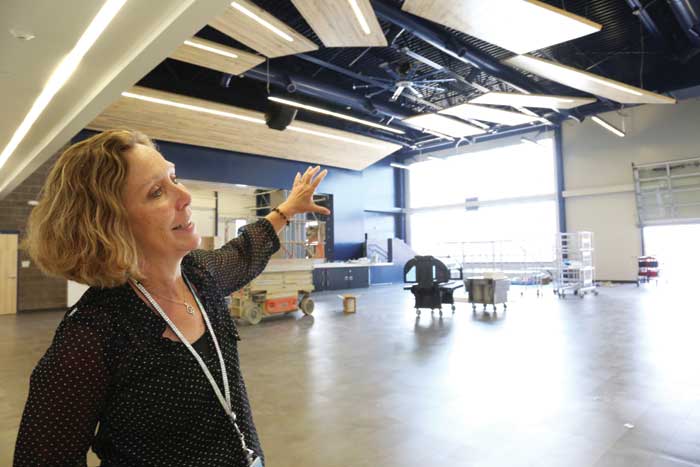
Principal and Lead Administrator Sonny Zinn points to wooden acoustical panels in the cafeteria that also contain lights. The cafeteria has a stage for student performances and a garage-style door that opens to the outdoors. The music room is located next to the cafeteria, behind a movable wall, so the combined area can be used for performances or assemblies.
Principal and Lead Administrator Sonny Zinn is excited to welcome students and families to the expansive new Isabella Bird Community School, after holding their first year in temporary quarters at the Samsonite building north of I-70. The school is named after Isabella Bird, who explored the Rocky Mountains on horseback in the 1870s. The new building will house 311 students in ECE through 5th grade this year. In two years, at full capacity, there will be three classes for each grade with up to 550 students. Zinn says she hopes the school will evolve into an ECE-8th grade school. While an addition would have to be built, some aspects needed for middle school grades are already in place, such as the regulation-sized gymnasium.
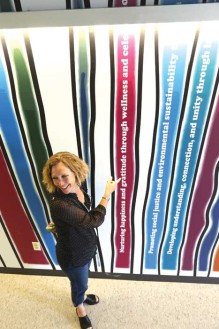
Zinn points out the guiding principles of Isabella Bird School, written into images of reeds that represent the plants found at nearby Bluff Lake.
The architecture of the building encourages the connection between the inside and nature. One wall of the cafeteria has a floor-to-ceiling window and a glass garage door that opens so that kids can eat inside or out. When the divider is up between the cafeteria and the music room next to it, the combined area becomes a community room for assemblies and performances.
Zinn believes the outdoor stage that extends off the music room nurtures kids’ imaginations. “Children love to put on impromptu plays,” she says. “Now they’ll be able to when they are out here for recess.” The stage opens to three playgrounds, each with a different developmental and physical need in mind: a wavy sidewalk where preschoolers can ride their strider bikes; overhead equipment to pull and swing on for the primary grades; and core body development for the older kids.
“I’ve certainly never worked with a school that has thought of that level of detail over every little thing,” says Zinn. “They (the architects) would bring ideas in and we’d bring ideas in and it would just be this synergy. It was what we want to have happen in our school. It really was this lovely bringing people together who are different stakeholders in the process, agreeing on something. It worked beautifully!”
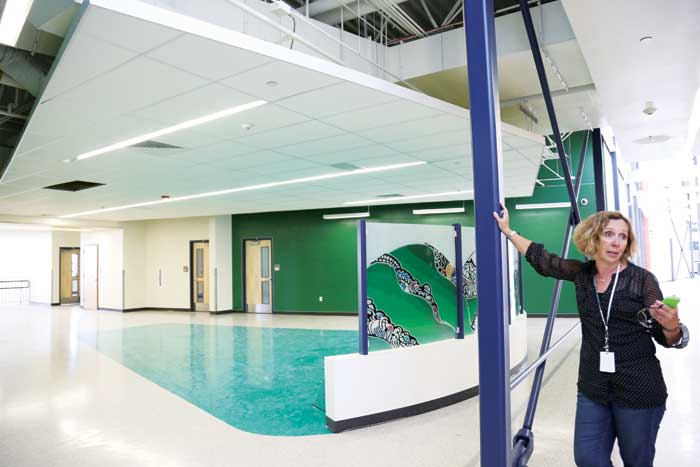
To create an open feeling in the school, Zinn chose to have brightly colored exposed beams rather than hiding the supports in internal walls. The photo shows one of the “pods” where same-grade classrooms gather.
Denver Discovery School
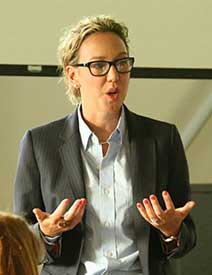
Denver Discovery Principal Kristen Atwood
Denver Discovery School is a brand new program that will be located in the space occupied by McAuliffe Middle School in 2013-14 (McAuliffe moved to the Smiley building starting in 2014-15). They will start the school year with a 10-day, Discovery RECRUIT program: Ready for – Excellence by showing our kids how to be – Confident in being a – Remarkably – Upstanding and – Impressive – Team of sixth-graders. This will include how students organize themselves, their lockers, their school materials, and their thoughts each morning to prepare for seven daily classes: four core and three electives.
Principal Kristen Atwood says highly qualified teachers will focus solely on their one subject each day, allowing them to instruct students who need extra support or modified lessons or are ready for more accelerated lessons. Project-based learning allows students to work at their own cognitive capacity as they create, explore, debate, research and finally present their findings. Students can work in groups or individually during these opportunities.
Atwood says learning should be 70 percent student centered—once teachers directly instruct between 15–20 minutes per lesson, the rest is facilitation of the learning.
Read an interview with Atwood here and find more information about Denver Discovery School in the Front Porch Middle School Guide.




So I’m going to 7th grade and I want to finish 7 grade in Dsst middle school. So I hope you guy can send me massage back.
I want to say that I really like Dsst middle school and I hope I can enjoy this school thanks.